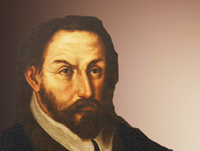In an Alma Mater that was embarking on its post-Tridentine decline, Gaspare Tagliacozzi was still a leading figure on the international scene. His interest in reconstructive facial operations soon brought him to prominence in the most prestigious courts as a renowned surgeon and anatomist.
 Gaspare Tagliacozzi was born in Bologna in 1545 to a wealthy family of artisans in the local silk industry.
Gaspare Tagliacozzi was born in Bologna in 1545 to a wealthy family of artisans in the local silk industry.
At the age of fifteen, he began studying Latin and philosophy at a grammar school in the city, and in 1565 he was able to enrol in the Faculty of Medicine at the University of Bologna.
During training, from 1567 to 1570, he was an assistant at the Hospital of Santa Maria della Morte, adjacent to the newly built Archiginnasio, the modern seat of the Alma Mater Studiorum (after the Unification of Italy, the Civic Archaeological Museum was housed in the hospital). This was a necessary apprenticeship in those days. After studying on what were often antiquated volumes, one learned in hospitals, where “doctoral students” performed a wide variety of tasks: from “ambulatory” patient selection, to minor surgical operations, from daily examinations alongside the doctor on duty, to managing barbers, supervising the creation of medicines by apothecaries and observing the dissection of corpses. The latter practice had been introduced into university studies in Bologna by Mondino de' Liuzzi in the early 14th century and had made the city's University one of the most up-to-date in investigating the workings of the human body.
Tagliacozzi had the best professors of the time as teachers: Girolamo Cardano for Theoretical Medicine, Ulisse Aldrovandi for Natural History and Giulio Cesare Aranzi for Anatomy and Surgery.
He graduated in 1570, immediately becoming Aranzi's assistant anatomist and a lecturer in Surgery, a position he held until 1590.
In order to be admitted to the College of Physicians, however, he also had to obtain a degree in Philosophy, which he did in 1576.
Gradually he made his mark in the city, earning the respect and acclaim of the upper classes and being elected for the first time in 1578 to the tribune of the plebs, a political role that concerned the regulation of food prices.
Over time, he specialised more and more in the care and treatment of facial wounds, which at the time were especially common among nobles and landowners, who were often scarred during military campaigns. His first text concerning the reconstruction of mutilated parts of the face, particularly noses, by means of skin grafting dates back to the 1580s. The text was sent in the form of an epistle to his Paduan colleague Girolamo Mercuriale, who published it in 1587 in the second edition of his De decoratione, a treatise on the relationship between beauty and medicine.
In 1590 , he was assigned the professorship of Theoretical Medicine, which he held until the end of his life, while also retaining his previous post as anatomist. For several years, he was also the administrator of the Gabella Grossa, the duty on goods, at the time managed by the University to pay university lecturers.
A rich clientele thus gathered around him, not only from Bologna but also from the central and northern courts. He himself amassed a fortune, partly due to the steady increase in his academic salaries, and could even afford numerous estates outside the city. His last years marked his consecration in the Olympus of modern medicine, so much so that he became personal physician to important figures such as the Duke of Mantua, Vincenzo Gonzaga.
The crowning achievement of his specialised studies and of the many activities performed in almost thirty years was the publication in Venice, in 1597, of the two volumes of the De curtorum chirurgia per insitionem (Surgery of mutilation by means of grafts). With innovative lucidity, Tagliacozzi absorbed the facial reconstruction practices tried and tested since the 15th century and expounded them with surprising methodology in a work not only unusually referred to a single surgical practice, but also admirably illustrated. The most common operation concerned the nose, for the reconstruction of which a flap of skin was cut off from the inside of the arm; the living flesh was placed on the mutilated or stripped part of the face and then grafted on (a practice learned from Aldrovandi and his plants in the Botanical Garden), so that the two parts would remain in contact for at least three weeks. Once the extremities had been sutured, the hospital stay could last up to twelve months.
This type of method, so articulated and time-consuming, did not always bear fruit, but certainly amazed those who emerged from it healed. Perhaps for this reason it is said that in 1600 a posthumous inquisition was unsuccessfully attempted, in which the well-known doctor was accused of witchcraft. This anecdote is still dubious, however, given the high esteem in which the renowned surgeon was held even by the Church, which had also entrusted him, through the Holy Office, with the task of revising the Index of Forbidden Books.
Tagliacozzi died in 1599 but his professionalism survived in the history of the University. To this day, his statue stands in the Anatomical Theatre of the Archiginnasio (which in Tagliacozzi's time this had not yet been established), holding an unfailing nose, while in Palazzo Poggi, the seat of the University, he can be found in one of the university picture gallery’s most beautiful portraits, by Tiburzio Passerotti, dressed in full regalia as he contentedly points to his volumes and illustrations of the operations that made him famous.
